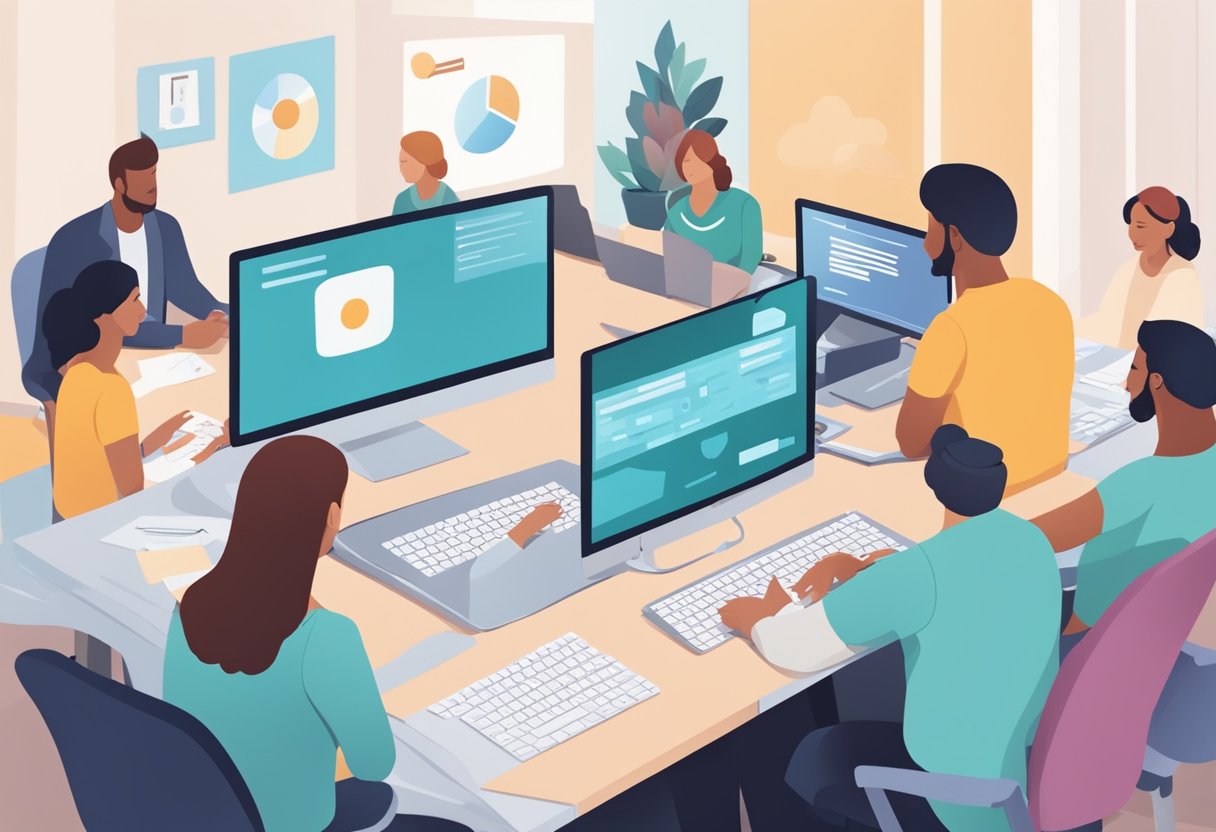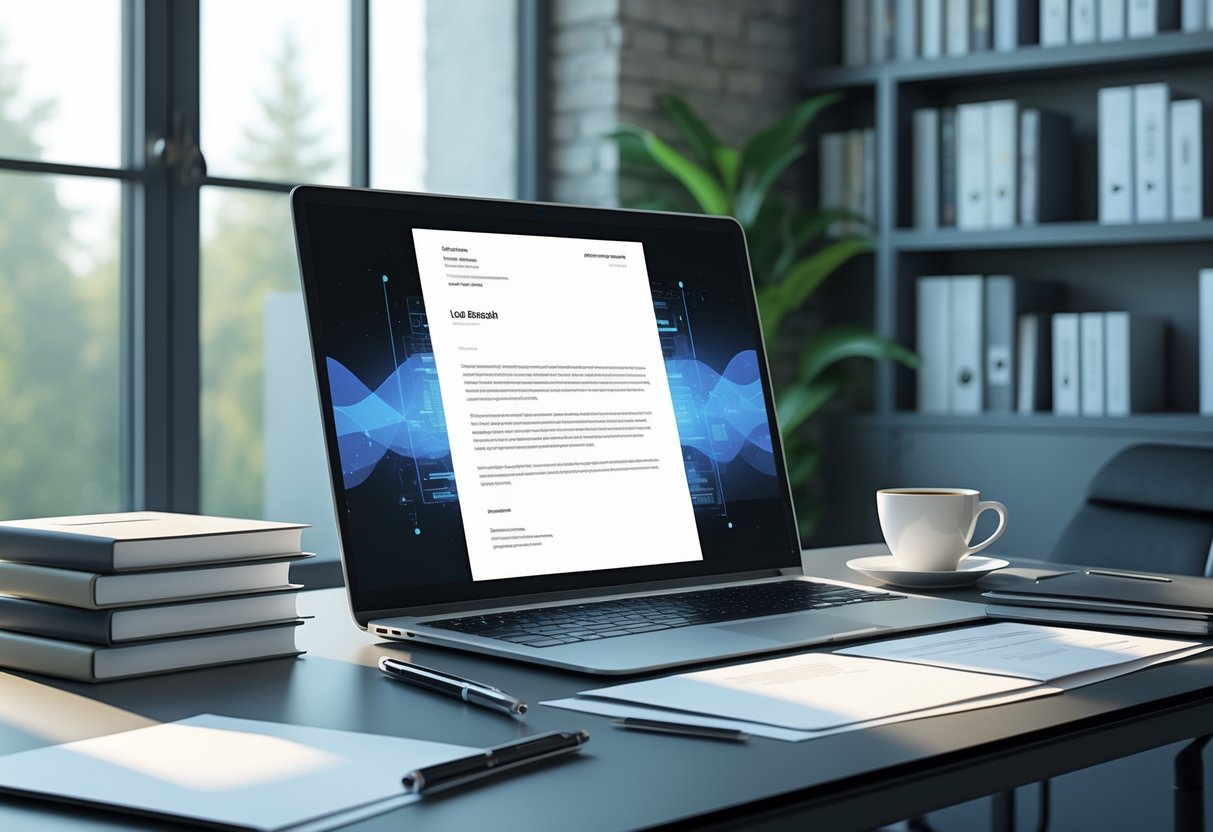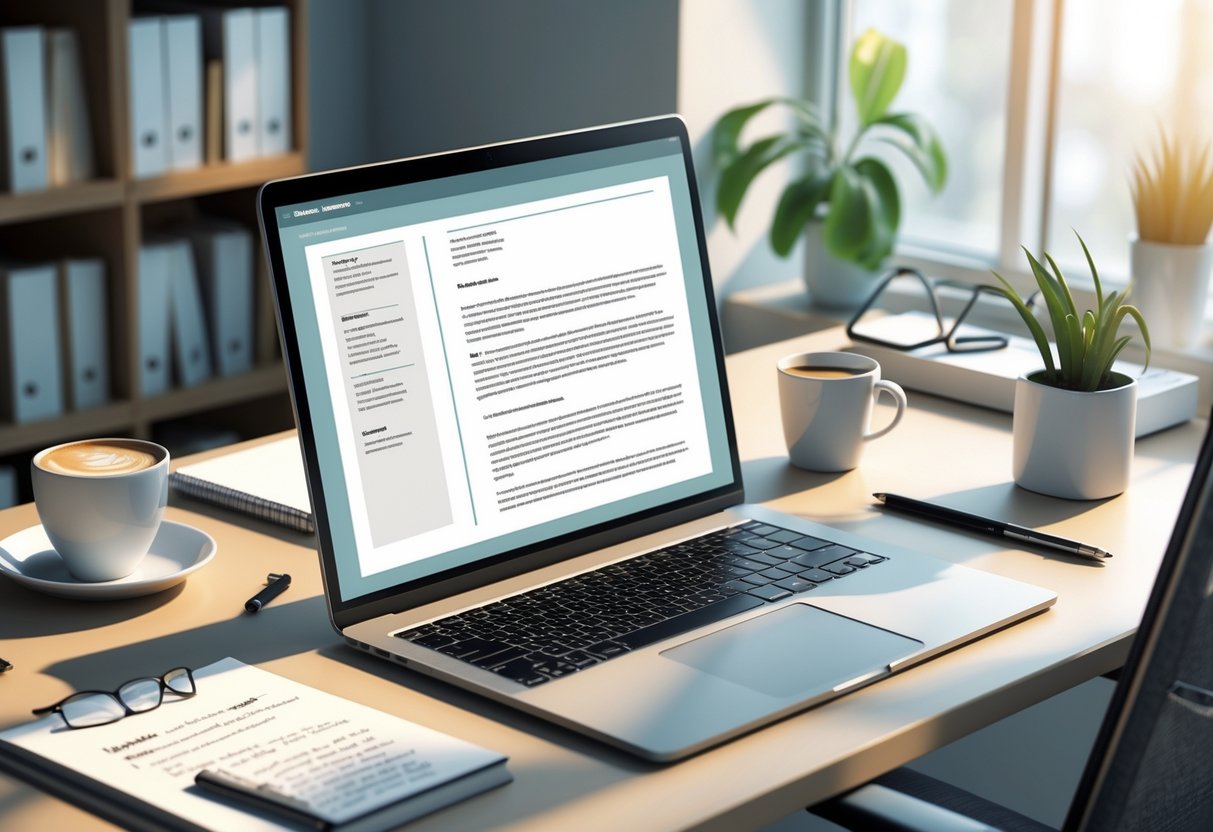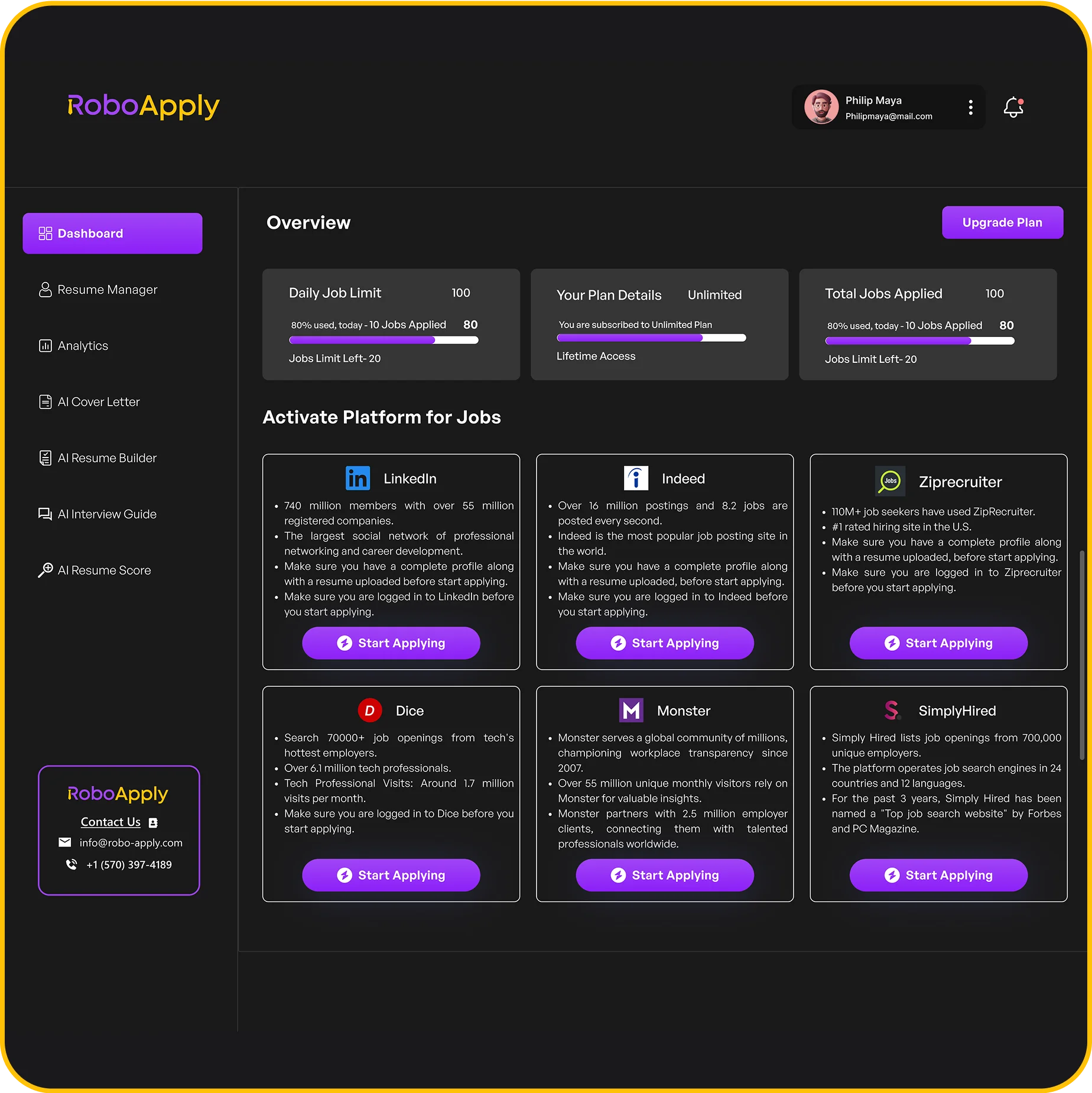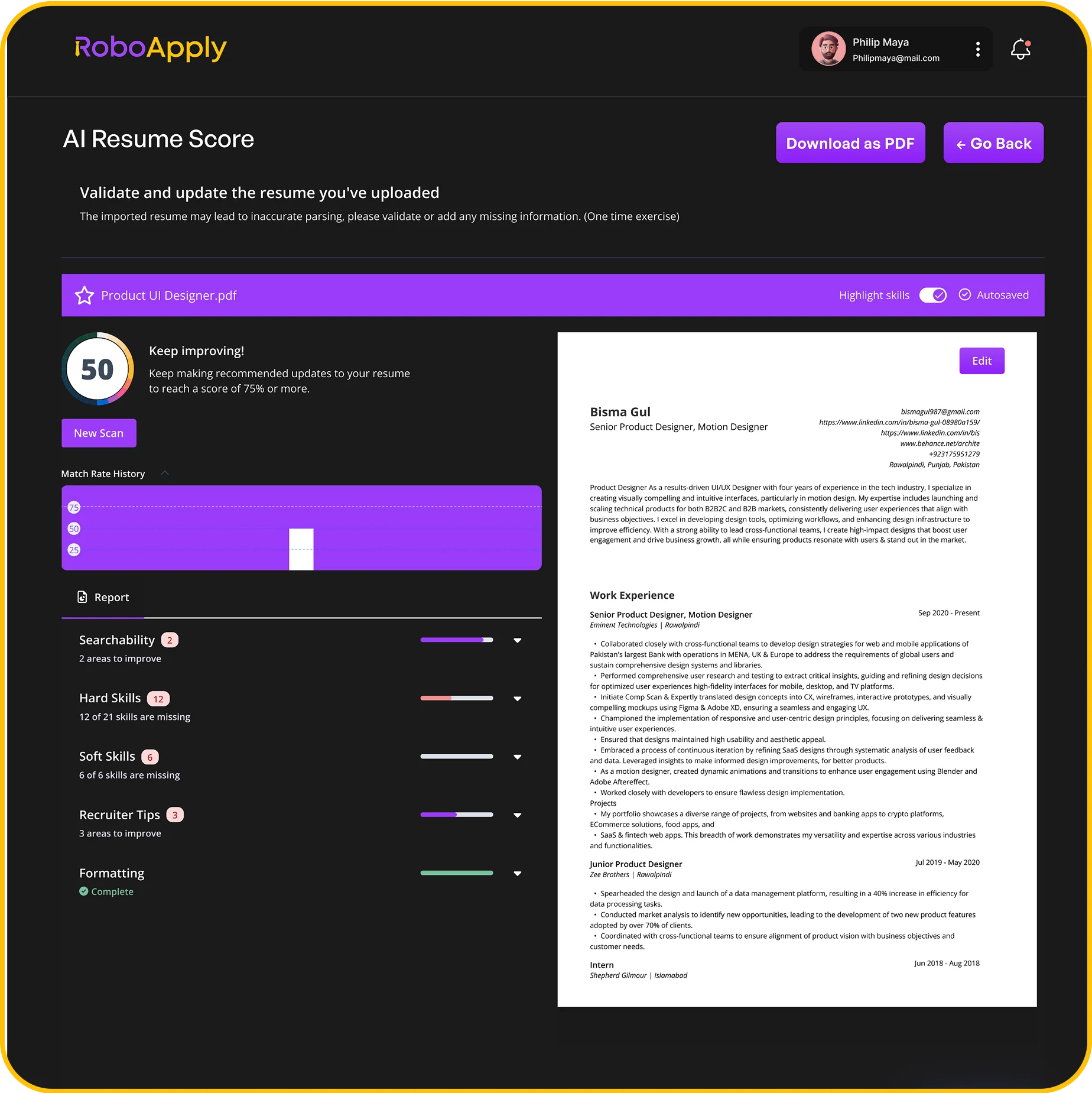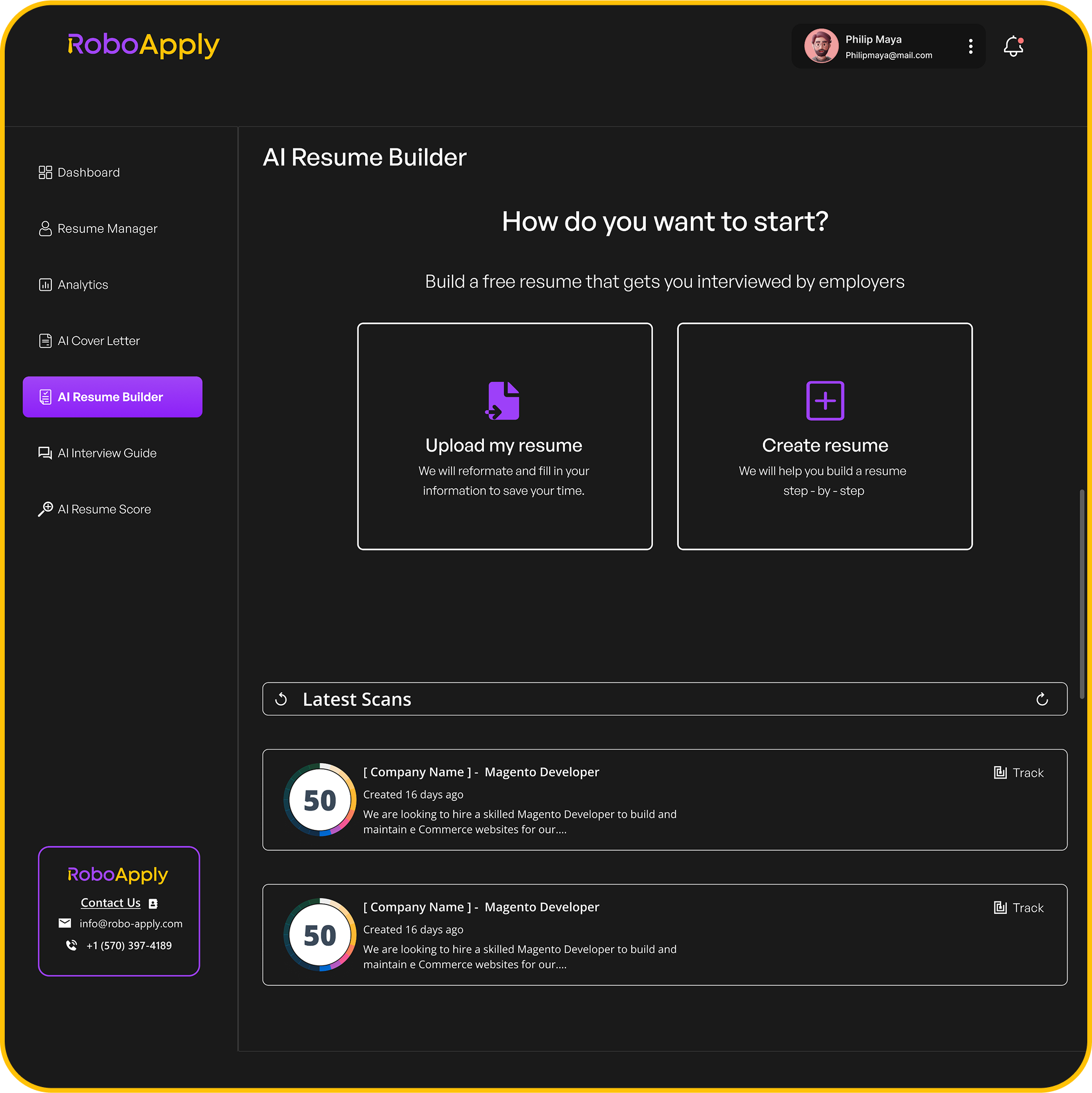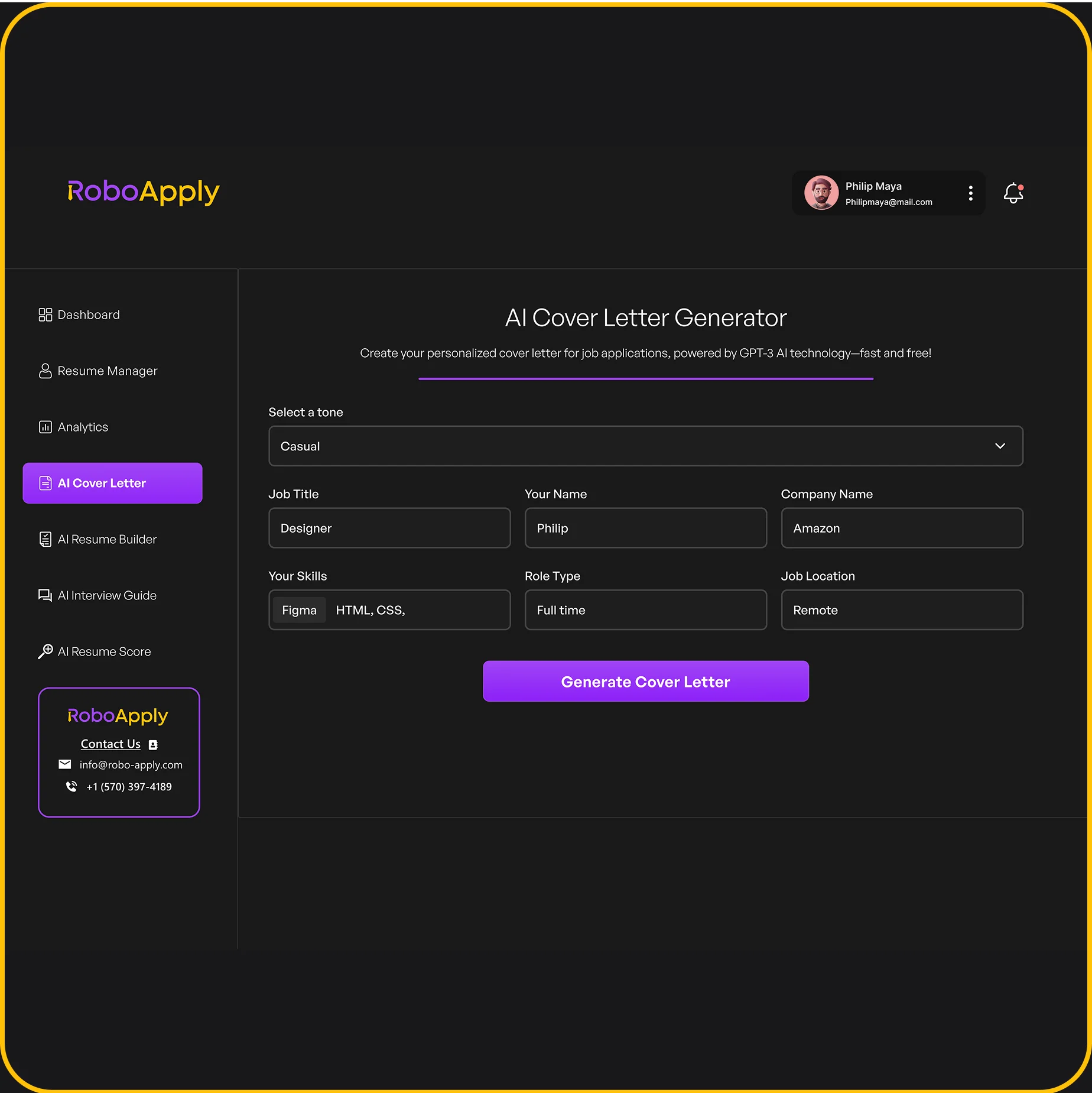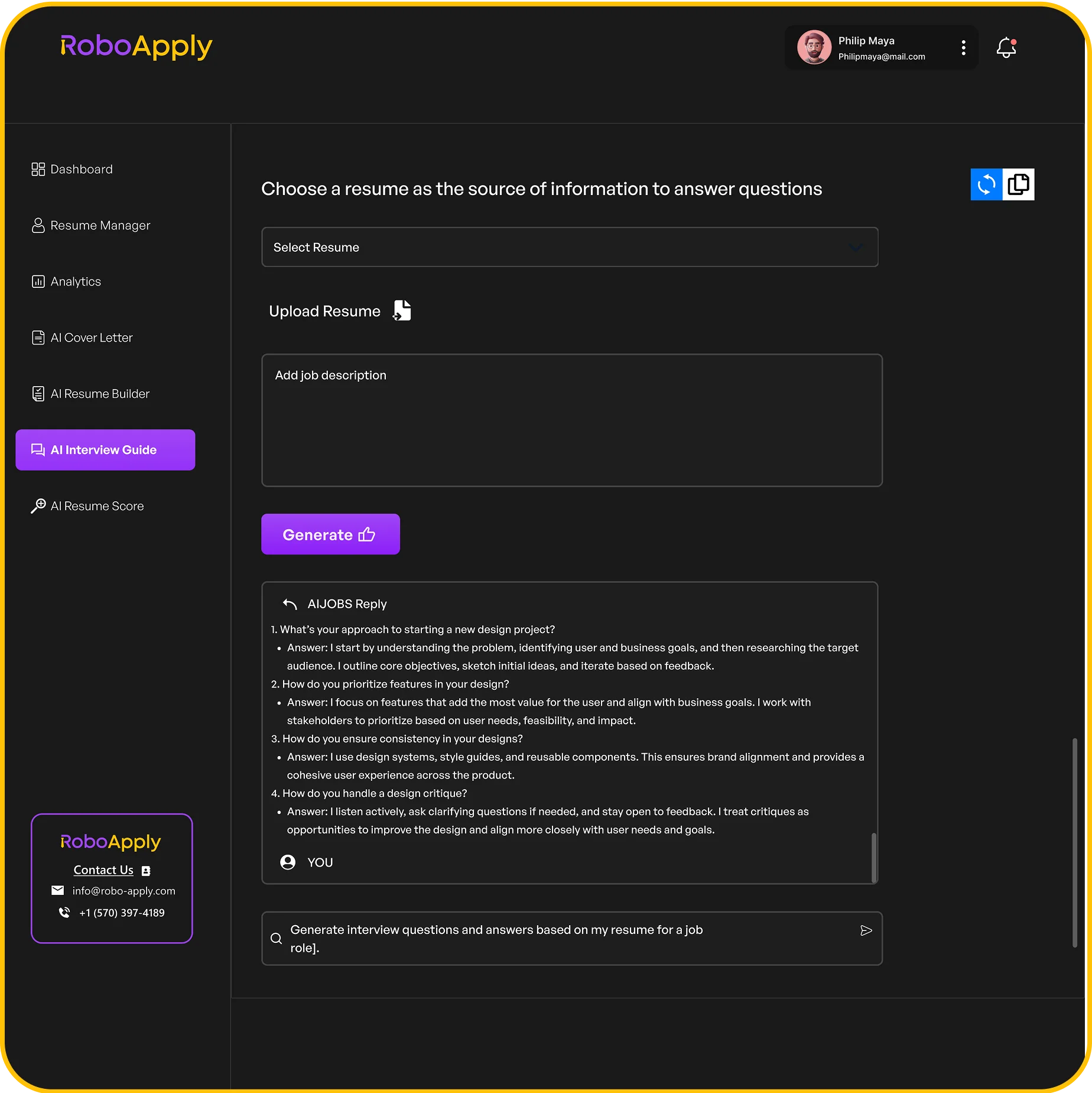4.9 ★★★★★ (228)
Applying for a federal job isn’t quite like applying anywhere else. There are all these rules, expectations, and, honestly, a fair bit of paperwork. Your cover letter? It needs to be detailed, clear, and laser-focused on those job requirements. A great federal job cover letter makes it obvious how your experience fits the position—and yes, you have to actually follow every instruction in the job posting. Skipping the cover letter or sending in something generic is a missed opportunity to show why you’re a great fit.

If you want to stand out, it’s worth learning the right structure, tone, and language for a federal cover letter. Even small slip-ups—like missing a detail or ignoring the job announcement’s instructions—can cost you. Tools like RoboApply can help with resume scoring, writing cover letters, and applying to jobs on sites like LinkedIn and Indeed. If you’re after a little extra help, you can Try RoboApply for free and see if it takes some of the pressure off.
Understanding Federal Job Cover Letters
Federal job cover letters come with their own set of quirks. They’re different from what you might send to a regular company. The main thing? Your letter should focus on how your experience ties into what the agency actually does—and what they need from you.
Differences from Private Sector Cover Letters
Federal cover letters usually feel more structured and formal than those in the private sector. You’ve got to address the specific job requirements listed in the posting. So, you’ll want to spell out exactly how your background matches each qualification. Bullet points are totally fine here—they can make it easier for the reader to see the connection.
Instead of talking about soft skills or general interests (which is more common in private sector letters), federal cover letters stick to the facts. Give specific examples and use the same language you see in the job announcement. Skip the fluffy stuff. For instance, say, “Provided training to five staff members on process improvement” instead of “I am a great leader.”
Private sector letters let you be a bit more flexible. Not so much with federal jobs—you really have to follow the agency’s instructions on things like format and length. If you don’t, your application might not even get looked at.
Role in the Federal Application Process
A cover letter isn’t always required for federal jobs, but it can be your chance to explain things not covered in your resume. Maybe you have a gap in your work history, or you’re switching careers, or you have some unique skill that matches the agency’s mission. The cover letter is where you can talk about all that. The U.S. Department of Labor points out that cover letters won’t verify your experience, but they can add useful context to your application.
If you’re making a big career shift, especially from private to federal, use the cover letter to show how your past experience lines up with the agency’s needs. It’s not a substitute for your resume, but it’s a great place to fill in the blanks and show why you’re excited about the agency’s mission.
Most federal applications happen online (think USAJOBS). RoboApply and similar tools can help you submit a targeted, professional cover letter, which can definitely make things less stressful. Might be worth trying RoboApply for free just to see if it saves you time.
Importance of Tailoring Your Cover Letter
Customizing your cover letter for each job is non-negotiable when it comes to federal applications. Do your homework: look up the agency, dig into the job description, and sprinkle in keywords from the announcement. Say you’re applying for an analyst gig at the Department of Labor—call out skills like “data analysis” or “policy evaluation” if they’re mentioned.
A generic letter? It’s easy to spot and usually gets ignored. To boost your odds, show how your skills directly support the agency’s main goals. Use examples that tie right back to the listed qualifications. For instance, talk about a project where you analyzed trends using the software they want, and share what happened as a result.
Sure, writing a new letter for every job can feel like a chore. Workflow tools like RoboApply can help you crank out customized cover letters and keep track of your applications. If you’re curious, Try RoboApply for free.
Analyzing the Job Description and Requirements
Before you start writing, take a really close look at the federal job posting. The best way to show you’re a match is to connect your skills and experience directly to the listed qualifications and duties.
Identifying Essential Qualifications
Federal job descriptions almost always spell out both minimum and preferred qualifications. Pay special attention to these sections. Make a note of required education, certifications, experience, or specific training. If something’s labeled “must-have” or “required,” it’s not optional.
It can help to highlight or jot down a checklist. For example, if the posting asks for “three years of project management experience and a bachelor’s degree in public administration,” you’d better mention those in your cover letter. Miss the essentials and your application might be tossed out before anyone even reads it.
Here’s a quick tip: Copy the job requirements into a table with columns for “Requirement,” “My Experience,” and “Example.” It makes it easier to spot where you’re covered and where you might need to elaborate.
Highlighting Relevant Skills
A lot of federal jobs include a section for “core skills” or “competencies”—stuff like communication, teamwork, technical know-how, or problem-solving. To stand out, address these skills directly in your cover letter, using phrases and examples from the job posting itself.
For example:
- If they want “strong written communication skills,” mention a time you wrote technical reports for supervisors.
- For “ability to work on a team,” share a story about a group project or committee you worked on.
Whenever possible, echo the exact wording from the job posting. It helps recruiters—and those pesky resume scanners—spot the keywords. If you want to make this even easier, Try RoboApply for free to analyze postings and highlight any skill gaps.
Incorporating Specific Examples
Listing skills isn’t enough. Federal recruiters want proof—real examples that show you’ve done what they need. The STAR method is a lifesaver here:
- Situation: What was the context?
- Task: What were you trying to accomplish?
- Action: What did you actually do?
- Result: What happened because of your actions?
Example:
“In my previous role as a program assistant, I led a team to update client records, using new database software. I trained four staff members, reduced errors by 20%, and completed the project two weeks early.” That’s the kind of detail that paints a clear picture.
If you want to organize your examples quickly, Try RoboApply for free—it can help auto-match your achievements with the job’s requirements.
Structuring Your Federal Cover Letter
A federal cover letter should show you truly get the job announcement, match your qualifications to their needs, and pay attention to the details. It’s all about looking professional and meeting the formal expectations of government hiring.
Choosing a Professional Format
Stick with a formal business letter format for federal jobs. Start with your name and contact info at the top, then the date, and the employer’s address.
Add a formal greeting, and keep everything left-aligned. No need for fancy layouts—just make it easy to read. Use line breaks between paragraphs, and end with something simple like “Sincerely,” before your name.
Keep it to one page. The ConnectComm guide for federal cover letters says it’s about quality, not quantity. Bullet points can help you connect your skills directly to the job requirements.
Here’s a quick template:
| Section | Details |
|---|---|
| Contact Details | Name, address, phone, email, date |
| Employer info | Agency name, title, address |
| Greeting | “Dear Hiring Manager,” or specific name |
| Body | 3–4 short paragraphs connecting skills to the job |
| Closing | “Sincerely,” and typed name |
Addressing the Hiring Manager
Whenever you can, address the hiring manager by name—it shows you’re paying attention. If there’s no name in the posting, try to find out by calling the agency or checking the announcement. Reddit users suggest calling the contact number if you’re stuck.
If you still can’t find a name, “Dear Hiring Manager:” works. Steer clear of “To Whom It May Concern”—it just feels a bit impersonal. And for U.S. government letters, use a colon (:) after the greeting.
Personalizing the greeting for every job is worth the effort. For example:
Dear Ms. Jones:
I am writing to apply for the Management Analyst position listed on USAJOBS…
A tailored greeting makes a good impression and shows you’re serious about the agency.
Using Effective Fonts
Use clear, professional fonts—nothing flashy. Times New Roman, Arial, or Calibri are all safe bets. Stick with 11 or 12-point size so your letter’s easy to read and doesn’t look crammed.
Skip the decorative fonts. They just make your application look off. Keep your font choices consistent between your cover letter and resume.
You can use bold or italics for headings or to highlight job titles, but don’t go overboard. Margins should be at least 1 inch so everything prints clearly on government systems.
If you want to save time on formatting (and content), RoboApply can help you create cover letters that look the part and meet government standards.
Try RoboApply for free
Crafting an Impactful Introductory Paragraph
Nailing the intro in your federal cover letter really matters. You want clear language, a direct mention of the job you’re after, and a tone that sounds genuinely interested—not robotic. That first paragraph sets the stage for everything that follows.
Stating the Position and Job Posting
Start off your cover letter by naming the exact position and job posting number. Federal agencies juggle lots of open roles, so getting straight to the point helps hiring managers know what you’re applying for right away. Mirroring the language from the actual federal job listing shows you’re paying attention—and honestly, it makes their lives a bit easier.
Here’s a clear opening sentence you might use:
“I am writing to express my interest in the Human Resources Specialist position (Job Announcement Number: HR-2025-145) at the U.S. Department of Agriculture, as advertised on USAJobs.”
This kind of opening keeps things simple and avoids any mix-ups. It also shows you know how the federal hiring process works and that you respect it. Mentioning where you found the job—whether on USAJobs, the agency’s site, or somewhere else—adds a bit more context, which never hurts.
To keep track of job postings and quickly pull up important details for your applications, RoboApply can be a real time-saver.
Expressing Enthusiasm for the Role
Once you’ve listed the job details, let them know why you’re actually excited about this particular federal role. Don’t just say you’re interested—show it. That little spark can help you stand out from the crowd.
Try connecting your own motivation to the agency’s mission or the purpose of the job. For example:
“I have long admired the Department’s effort to improve community health, and I am eager to contribute my skills in data analysis to support its outreach programs.”
Being specific about what draws you to the role—maybe it’s the agency’s mission, the kind of impact you could make, or the professional growth you see—makes your intro feel a lot more real.
If you’re looking to save time and still personalize each cover letter, tools like RoboApply offer sample letters and feedback to help you strike the right tone for each agency.
Try RoboApply for free to make your federal job search a little less overwhelming, improve your cover letters, and keep tabs on all your applications.
Showcasing Skills and Achievements
Writing a federal cover letter isn’t just about rattling off your experience. You want to draw a clear line between your skills, what you’ve achieved, and what the agency actually needs. The more concrete you can be, the better.
Aligning Experience with Federal Needs
Matching your background to the job requirements is key. Read the job announcement carefully and jot down the must-have skills—teamwork, problem-solving, leadership, whatever they mention.
Then, use the cover letter to show exactly how you fit the bill. If they want project management, talk about a project you managed and what happened. Use action verbs like “organized,” “coordinated,” or “developed.” If you’ve used federal-specific tools (like RoboApply for resume scoring), mention that to show you’re familiar with the process.
Here’s a super simple way to organize your thoughts:
| Agency Requirement | Applicant’s Experience |
|---|---|
| Analytical Skills | Completed data analysis internship at EPA |
| Written Communication | Authored reports used in grant proposals at university |
| Teamwork | Led a team of 5 in volunteer project |
Emphasizing Results and Contributions
Federal agencies are all about results and facts, not just nice-sounding statements. When you talk about your past roles or internships, share specific achievements and try to back them up with numbers or clear outcomes.
Instead of saying “Assisted in budget planning,” go with something like, “Assisted in planning and managing a $250,000 budget, resulting in a 12% cost reduction for the department.” That paints a way clearer picture.
Some quick examples:
- Reduced processing time for reports by 20% in previous role.
- Managed a student internship project that reached 95% completion rate.
- Implemented a new filing system adopted agency-wide.
Details matter. When you can, show the impact you made. If you want extra help tailoring your cover letter, RoboApply for free can help you highlight the right achievements and keep your application sharp.
Try RoboApply for free.
Concluding and Polishing Your Cover Letter
Wrapping up a cover letter takes a bit of care. A well-crafted closing—and a little editing—can help you stand out in the federal hiring crowd.
Writing a Strong Closing Paragraph
A good closing paragraph brings everything together and makes a final case for why you’re a great fit. Show some real enthusiasm for the job and remind them, briefly, what you bring to the table. It helps to sprinkle in a few keywords from the job posting.
Stay professional, but don’t go overboard with the formalities. Phrases like “Thanks for your time” or “Hope to hear from you soon” don’t really add much. Something like, “I am eager to further discuss how my skills in project management and policy analysis can directly benefit your team,” feels more direct.
Confidence is good—arrogance, not so much. You can also highlight one last achievement as a reminder. RoboApply can help you personalize your closing by scoring your letter and offering last-minute tips. Try RoboApply for free.
Requesting an Interview
When it comes to asking for an interview, be clear and upfront. This is your chance to show you’re interested in moving forward.
Skip the wishy-washy stuff. Instead of “I would appreciate an interview,” try, “I welcome an interview to further discuss my fit for this position.” It’s more confident and sets the expectation for next steps.
Be polite, but let them know you’re eager to contribute. If you can, mention your availability, like:
- “I am available for an interview at your earliest convenience and look forward to further discussing my qualifications.”
A simple thank you for their consideration keeps things professional. For more ideas, here’s a guide on how to close a cover letter professionally.
Proofreading and Final Edits
Proofreading might sound basic, but it’s huge. Even little mistakes can leave a bad impression.
Read your cover letter slowly, line by line. Watch for typos, awkward phrasing, or anything that just feels off. Double-check things like the agency name, job title, and your contact info. Reading it out loud (even if it feels silly) can catch errors your eyes might skip.
Spellcheck tools help, but don’t trust them alone. Getting feedback from a friend or using a job search tool can catch what you miss. RoboApply can run automated checks and suggest edits too. Try RoboApply for free and see if it speeds up your editing on those endless job applications.
Leveraging Support and Feedback
Writing a cover letter for a federal job is a lot easier (and usually better) if you get some help. Honest feedback from people who know the system can make a real difference.
Consulting Career Coaches
Career coaches can give you advice tailored to federal applications. They know what hiring managers want to see and can help you highlight your best skills and achievements. Some offer practice interviews, resume reviews, or even full rewrites.
If you’re meeting with a coach, bring a draft, the job announcement, and your career goals. That way, the coach can give you specific feedback—maybe suggesting you rearrange sections or punch up your federal-specific skills. For example, they might say, “Instead of ‘I led a team,’ try ‘I led a team of 10 analysts, improving project delivery by 20%.’”
Coaches may also recommend digital tools. If you like real-time feedback, you can Try RoboApply for free.
Networking with Federal Employees
Connecting with people already working in the federal government can give you the inside scoop. You can meet folks at professional events, in online forums, or even just by reaching out on LinkedIn.
When you contact federal employees, be specific and considerate. Something like, “Hi, I am preparing a cover letter for a position at your agency. Could you share what you think makes an applicant stand out?” works well.
These employees can help you tailor your cover letter to match the agency’s language and requirements. Sometimes, they’ll even share examples or stories that can guide you. Getting a referral or a tip from someone inside can really strengthen your application.
Getting Feedback from Hiring Managers
It’s pretty rare, but if you get feedback from a hiring manager, take it seriously. If you land an interview—or even if you’re rejected—it never hurts to ask for advice. A simple message works:
“Thank you for considering my application. If possible, could you share any feedback about my cover letter or how I might improve for future openings?”
Sometimes, federal job postings list the hiring manager’s contact info. If it feels right, following up shows initiative and can teach you what the agency is really looking for. Over time, collecting this feedback helps you fine-tune your approach for the next round.
To make things easier, you can Try RoboApply for free to help track your applications and use built-in feedback tools.
Frequently Asked Questions
Federal job cover letters are a bit of a puzzle and need to match the job announcement closely. Here are some common questions (and answers) that pop up for applicants.
What are the key elements to include in a cover letter for a federal job?
Start with your name and contact info at the top. Then add the date and the agency or department’s contact details. Always mention the job title and announcement number.
State your interest in the job and agency. Give a quick summary of your background and refer to the specific qualifications from the posting. Use short paragraphs for each point—skills, achievements, whatever lines up with the job. Wrap up by thanking the hiring manager for considering you.
How can one tailor a cover letter to a specific federal agency or position?
Dig into the agency’s mission, values, and any recent projects. Mention these directly in your letter. For example, if it’s the Department of Labor, talk about your experience with workplace rights if you have it.
Make sure your skills and experience match the qualifications listed in the job ad. Use the same language they use—it shows you’re paying attention. This makes your letter feel more relevant. There’s more advice in this cover letter for government jobs guide.
Is a cover letter mandatory when applying for government jobs through USAJOBS?
Usually, a cover letter is optional for most federal jobs on USAJOBS—unless the job announcement specifically asks for one.
That said, adding a cover letter lets you explain things not in your resume and make your case for why you’re a good fit. According to USAJOBS help, cover letters give you a little extra space to talk to hiring officials if you need it. You can check out more about what documents are required for USAJOBS applications.
What tips can improve the chances of standing out in a federal job application cover letter?
Seriously, personalize each cover letter—don’t just copy and paste the same thing for every job. If you can find the hiring manager’s name, use it; it’s a small thing, but it really does help.
Try to spotlight a few accomplishments that actually connect to the job you’re after. Instead of just listing what you did, talk about what you achieved (and, honestly, don’t be afraid to brag a little). Keep it short—one page is plenty. Double-check for typos or weird grammar slips; it’s amazing how often those sneak in. Online tools like RoboApply can make the whole process less painful, and sometimes they even catch things you’d miss. Try RoboApply for free if you want to see how your cover letter stacks up.
How should I address key qualifications and competencies in my government job cover letter?
Line up your skills and experience with the “requirements” or “qualifications” from the job posting. Don’t just say you have a skill—give a real example from your past work.
For instance, if they want project management experience, mention a specific project you led, what happened, and what you actually did. If teamwork’s important, throw in a quick story about a time you worked well with others. It helps to use the same keywords they list in the posting; it’s a bit formulaic, but hey, it works.
Can you provide an example structure of a federal job cover letter?
Here’s a basic template you can riff on:
[Your Name]
[Your Address]
[City, State, ZIP Code]
[Phone Number]
[Email Address]
[Date]
[Hiring Manager’s Name]
[Agency Name]
[Agency Address]
[City, State, ZIP Code]
Dear [Hiring Manager’s Name],
I’m reaching out to throw my hat in the ring for the [Job Title] position—Announcement Number [Job Announcement Number]—at [Agency Name]. Over the past [number] years, I’ve picked up a lot in [relevant skill area], mostly through my work as a [previous role or field]. It’s been quite a journey.
At [Previous Employer], I managed to [describe a key achievement that actually lines up with the job requirements]. My experience in [related field or responsibility] really connects with what [Agency Name] is all about—like the time I [specific example]. I honestly believe my background in [another skill from the job posting] could add something useful to your team.
If you think I might be a good fit, I’d love to chat more about how my experience lines up with what you’re looking for. Thanks for considering my application.
Sincerely,
[Your Name]
A cover letter that sounds like you—and actually fits the job—can make a difference. If you want to speed things up, Try RoboApply for free.




